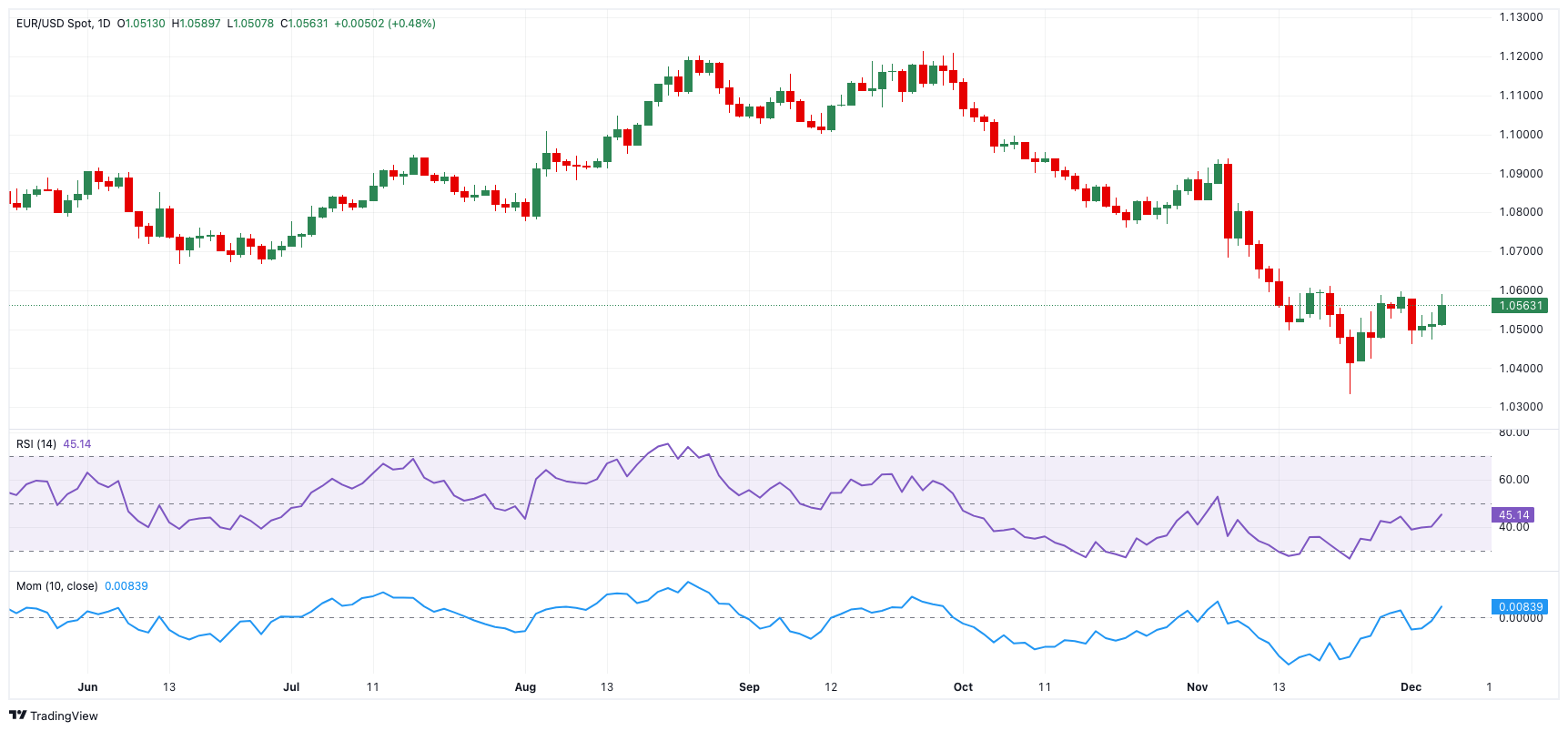EUR/USD Price Forecast: The hunt for the 1.0600 barrier
Premium|
You have reached your limit of 5 free articles for this month.
Get all exclusive analysis, access our analysis and get Gold and signals alerts
Elevate your trading Journey.
UPGRADE- EUR/USD extended its weekly optimism and approached 1.0600.
- The US Dollar remained well on the defensive amid mixed yields.
- All the attention is now on the release of the US Nonfarm Payrolls.
EUR/USD extended its recovery on Thursday, adding to the ongoing broad-based optimism and climbing to the vicinity of the key barrier at 1.0600 the figure. This rebound eased some of the downward pressure from recent lows, helped by a softer US Dollar and a reduction in political uncertainty in France after PM Michel Barnier's stepped down.
Spotlight on central banks
Monetary policy remains the driving force behind market movements. On November 7, the Federal Reserve (Fed) lowered its benchmark interest rate by 25 basis points to a range of 4.50%-4.75%, continuing its efforts to combat inflation. However, cracks are beginning to appear in the US labour market, even as unemployment remains near historical lows.
Fed Chair Jerome Powell struck a cautious note, suggesting the current rate cuts may be sufficient for now, tempering speculation about further easing in December. FOMC Governor Michelle Bowman reinforced this view, advocating for a patient approach to future policy changes.
In addition, speaking at an event on Wednesday, Powell expressed confidence that the new administration would respect the Fed’s independence. He also highlighted that the economy's resilience provides room for a measured approach to future rate adjustments.
Across the Atlantic, the European Central Bank (ECB) has kept rates steady since October, when it reduced the deposit rate to 3.25%. Inflation remains a significant concern, with November data showing renewed price pressures in Germany and the Eurozone. Wages across the bloc also accelerated, climbing to 5.42% in the third quarter.
ECB President Christine Lagarde maintained a neutral tone in her recent comments, although she acknowledged that growth risks in the euro area remain tilted to the downside.
Trade policies add uncertainty
Adding to the mix, former US President Donald Trump’s proposed trade policies loom as a potential source of market instability. New tariffs could drive up US inflation, possibly forcing the Fed to adopt a more aggressive stance. Such a scenario would likely strengthen the US Dollar, creating additional headwinds for EUR/USD.
EUR/USD daily chart
EUR/USD technical outlook
The technical picture for EUR/USD continues to favour the bears. Key support levels include the 2024 low of 1.0331 from November 22, followed by 1.0290 and 1.0222, levels last seen in November 2022.
On the upside, immediate resistance lies at 1.0609, the high from November 20, with further targets at the 200-day Simple Moving Average (SMA) at 1.0844 and the November peak of 1.0936.
However, the broader bearish trend remains intact as long as the pair trades below the 200-day SMA.
On the four-hour chart, the pair shows signs of consolidation. Resistance levels to watch include 1.0596, 1.0609, and 1.0653, while support can be found at 1.0460, 1.0424, and the key 1.0331 mark.
Momentum indicators suggest further upside could be in the offing, with the Relative Strength Index (RSI) hovering around 60, although the Average Directional Index (ADX) indicating a weak trend at nearly 20.
Bottom line
EUR/USD remains under pressure from a mix of USD strength, political developments, and divergent monetary policies between the Fed and ECB. While the pair has managed a modest recovery, it remains vulnerable to further declines as market dynamics continue to evolve.
- EUR/USD extended its weekly optimism and approached 1.0600.
- The US Dollar remained well on the defensive amid mixed yields.
- All the attention is now on the release of the US Nonfarm Payrolls.
EUR/USD extended its recovery on Thursday, adding to the ongoing broad-based optimism and climbing to the vicinity of the key barrier at 1.0600 the figure. This rebound eased some of the downward pressure from recent lows, helped by a softer US Dollar and a reduction in political uncertainty in France after PM Michel Barnier's stepped down.
Spotlight on central banks
Monetary policy remains the driving force behind market movements. On November 7, the Federal Reserve (Fed) lowered its benchmark interest rate by 25 basis points to a range of 4.50%-4.75%, continuing its efforts to combat inflation. However, cracks are beginning to appear in the US labour market, even as unemployment remains near historical lows.
Fed Chair Jerome Powell struck a cautious note, suggesting the current rate cuts may be sufficient for now, tempering speculation about further easing in December. FOMC Governor Michelle Bowman reinforced this view, advocating for a patient approach to future policy changes.
In addition, speaking at an event on Wednesday, Powell expressed confidence that the new administration would respect the Fed’s independence. He also highlighted that the economy's resilience provides room for a measured approach to future rate adjustments.
Across the Atlantic, the European Central Bank (ECB) has kept rates steady since October, when it reduced the deposit rate to 3.25%. Inflation remains a significant concern, with November data showing renewed price pressures in Germany and the Eurozone. Wages across the bloc also accelerated, climbing to 5.42% in the third quarter.
ECB President Christine Lagarde maintained a neutral tone in her recent comments, although she acknowledged that growth risks in the euro area remain tilted to the downside.
Trade policies add uncertainty
Adding to the mix, former US President Donald Trump’s proposed trade policies loom as a potential source of market instability. New tariffs could drive up US inflation, possibly forcing the Fed to adopt a more aggressive stance. Such a scenario would likely strengthen the US Dollar, creating additional headwinds for EUR/USD.
EUR/USD daily chart
EUR/USD technical outlook
The technical picture for EUR/USD continues to favour the bears. Key support levels include the 2024 low of 1.0331 from November 22, followed by 1.0290 and 1.0222, levels last seen in November 2022.
On the upside, immediate resistance lies at 1.0609, the high from November 20, with further targets at the 200-day Simple Moving Average (SMA) at 1.0844 and the November peak of 1.0936.
However, the broader bearish trend remains intact as long as the pair trades below the 200-day SMA.
On the four-hour chart, the pair shows signs of consolidation. Resistance levels to watch include 1.0596, 1.0609, and 1.0653, while support can be found at 1.0460, 1.0424, and the key 1.0331 mark.
Momentum indicators suggest further upside could be in the offing, with the Relative Strength Index (RSI) hovering around 60, although the Average Directional Index (ADX) indicating a weak trend at nearly 20.
Bottom line
EUR/USD remains under pressure from a mix of USD strength, political developments, and divergent monetary policies between the Fed and ECB. While the pair has managed a modest recovery, it remains vulnerable to further declines as market dynamics continue to evolve.
Information on these pages contains forward-looking statements that involve risks and uncertainties. Markets and instruments profiled on this page are for informational purposes only and should not in any way come across as a recommendation to buy or sell in these assets. You should do your own thorough research before making any investment decisions. FXStreet does not in any way guarantee that this information is free from mistakes, errors, or material misstatements. It also does not guarantee that this information is of a timely nature. Investing in Open Markets involves a great deal of risk, including the loss of all or a portion of your investment, as well as emotional distress. All risks, losses and costs associated with investing, including total loss of principal, are your responsibility. The views and opinions expressed in this article are those of the authors and do not necessarily reflect the official policy or position of FXStreet nor its advertisers.
